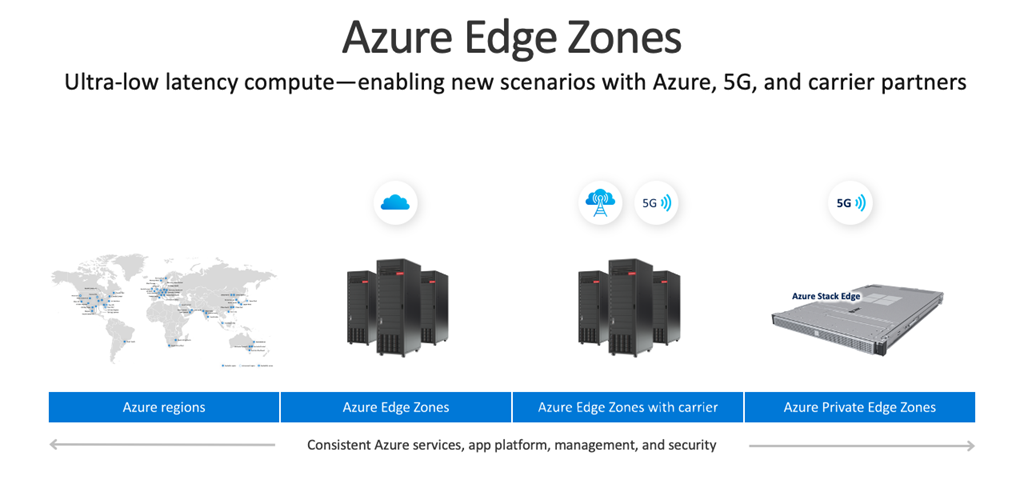Azure Edge Zones will enable a new era of 5G applications
Microsoft has partnered with the mobile industry to unlock new 5G scenarios with Azure Edge Zones.

Microsoft has announced its new Azure Edge Zones service, which enables customers to use edge computing to connect to existing Azure ‘services’, opening up a new era of 5G use cases, especially in the areas of online gaming, remote meetings and events, and smart infrastructure.
Microsoft is hoping to take advantage of the low-latency and speed of 5G by enabling local data processing at the edge of the network, whilst working in tandem with distributed applications across cloud, or on-premises. And with Azure Edge Zones, customers will also get consistency across the user experience, via Azure Portal, APIs, and Microsoft’s security tools.
“This will enable developers to build optimized and scalable applications using Azure and directly connected to 5G networks, taking advantage of consistent Azure APIs and tooling available in the public cloud.”
Yousef Khalidi, Azure Networking.
In a blog post to promote the launch of the new service, Yousef Khalidi, Corporate Vice President of Azure Networking, explained how the new service would work.
“Building on our previous work with AT&T, we’re announcing the preview of Azure Edge Zones with carriers, connecting Azure services directly to 5G networks in the carrier’s datacenter,” said Khalidi. “This will enable developers to build optimized and scalable applications using Azure and directly connected to 5G networks, taking advantage of consistent Azure APIs and tooling available in the public cloud.”
For its initial roll-out Microsoft will be working with AT&T, one of its key technology partners in the telecoms industry. In 2019, Microsoft Azure was the first public cloud to announce 5G integration with AT&T in Dallas, and now the two companies will work on delivering resources to the edge.
“This is a uniquely challenging time across the globe as we rethink how to help organizations serve their customers and stakeholders,” said Anne Chow, chief executive officer, AT&T Business. “Fast and intelligent mobile networks will be increasingly central to all of our lives. Combining our network knowledge and experience with Microsoft’s cloud expertise will give businesses a critical head start.”
Three key areas
The collaboration with AT&T on a new Edge Zone, targeted to become available in Los Angeles in late spring, will enable customers and partners to get a taste of what can be achieved via edge computing.
Get up to speed with 5G, and discover the latest deals, news, and insight!

And according to Microsoft, these new zones will boost application performance, providing an optimal user experience. And the company outlined three key areas that it expects to :
- Online gaming: Every press of the button, every click is important for a gamer. Responsiveness is critical, especially in multi-player scenarios. Game developers can now develop cloud-based applications optimized for mobile, directly accessing the 5G network at different carrier sites. They can achieve millisecond latency and scale to as many users as they want.
- Remote meetings and events: As the prevalence of digital-forward experiences continue to rise in response to global health challenges, we can help bring together thousands of people to enjoy a real-time shared experience. Enabling scenarios like social engagement, mobile digital experiences, live interaction, and payment and processing require ultra-low latency to provide an immersive, responsive experience.
- Smart Infrastructure: With the rise of IoT, organizations are looking to create efficiency, savings, and immersive experiences across residential and commercial buildings, or even citywide. With 5G and cloud computing, organizations can reliably connect millions of endpoints, analyze data, and deliver immersive experiences.
Those looking to take part in the Microsoft and AT&T Los Angeles partnership can now apply to do so as an early adopter.

Dan is a British journalist with 20 years of experience in the design and tech sectors, producing content for the likes of Microsoft, Adobe, Dell and The Sunday Times. In 2012 he helped launch the world's number one design blog, Creative Bloq. Dan is now editor-in-chief at 5Gradar, where he oversees news, insight and reviews, providing an invaluable resource for anyone looking to stay up-to-date with the key issues facing 5G.

